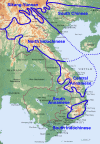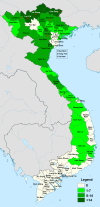Checklist to the Elatostema (Urticaceae) of Vietnam including 19 new records, ten new combinations, two new names and four new synonyms
- PMID: 30648016
- PMCID: PMC6330208
- DOI: 10.7717/peerj.6188
Checklist to the Elatostema (Urticaceae) of Vietnam including 19 new records, ten new combinations, two new names and four new synonyms
Abstract
Elatostema (Urticaceae) comprises several hundred herbaceous species distributed in tropical and subtropical Africa, Asia, Australia and Oceania. The greatest species richness occurs on limestone karst in Southeast Asia. Taxonomic revisions of Elatostema are largely out of date and contradict each other with respect to the delimitation of Elatostema and Pellionia. Most herbaria in SE Asia and worldwide contain significant amounts of unidentified material. As part of a broader revision of Elatostema in SE Asia, we present an updated checklist for Vietnam based on field visits, a review of specimens in herbaria worldwide, a review of type material and nomenclature. We recognize 77 taxa (75 species and two infraspecific taxa) of Elatostema in Vietnam, 23 of which were previously ascribed to Pellionia. Nineteen of these are new records for the country, i.e., E. attenuatoides, E. austrosinense, E. backeri, E. brunneinerve, E. crassiusculum, E. crenatum, E. fengshanense, E. glochidioides, E. malacotrichum, E. nanchuanense, E. oblongifolium, E. obtusum, E. oppositum, E. pergameneum, E. prunifolium, E. pseudolongipes, E. pycnodontum, E. salvinioides and E. xichouense. We place E. baviensis in synonymy of E. platyphyllum, E. colaniae in synonymy of E. myrtillus, P. macroceras in synonymy of E. hookerianum, and P. tetramera in synonymy of E. dissectum for the first time. Fourteen taxa (18% of all the recognized taxa) are endemic to Vietnam, which makes Elatostema one of the richest genera for endemic species in this country; this level of endemism is comparable to levels observed in Orchidaceae. Our checklist suggests that the highest diversity and endemism of Elatostema occurs in northern Vietnam, and that there is the greatest floristic similarity of northern Vietnam to SW China. The relationship among floristic regions is also investigated. We could find no records of Elatostema for 33 out of 63 provincial units of Vietnam, including all the southernmost provinces. We propose that further studies on the diversity of Elatostema in central and southern Vietnam are severely needed.
Keywords: Begonia; Elatostemateae; Flora of Vietnam; Indochina; Karst; Lectotypification; Limestone; Orchidaceae; Pellionia; Taxonomy.
Conflict of interest statement
The authors declare there are no competing interests.
Figures







References
-
- Averyanov L, Cribb PJ, Phan KL, Nguyen TH. Slipper orchids of Vietnam: with an introduction to the Flora of Vietnam. Royal Botanic Gardens, Kew; Kew: 2003c. p. 308.
-
- Averyanov LV, Loc PK, Hiep NT, Doan DT. Highland vegetation and flora of Van Ban District, Lao Cai province in northern Viet Nam. Turczaninowia. 2003b;6:47–86.
-
- Averyanov LV, Loc PK, Hiep NT, Harder DK. Phytogeographic review of Vietnam and adjacent areas of Eastern Indochina. Komarovia. 2003a;3:1–83.
-
- Averyanov LV, Nguyen HQ. Eleven new species of Begonia L. (Begoniaceae) from Laos and Vietnam. Turczaninowia. 2012;15:5–32.
-
- Backer CA. Elatostema. In: Backer CA, Bakhuizen van den Brink Jr RC, editors. Flora of Java. Vol. 2. N v P. Noordhoff; Groningen: 1965. pp. 42–44.
LinkOut - more resources
Full Text Sources
Research Materials

